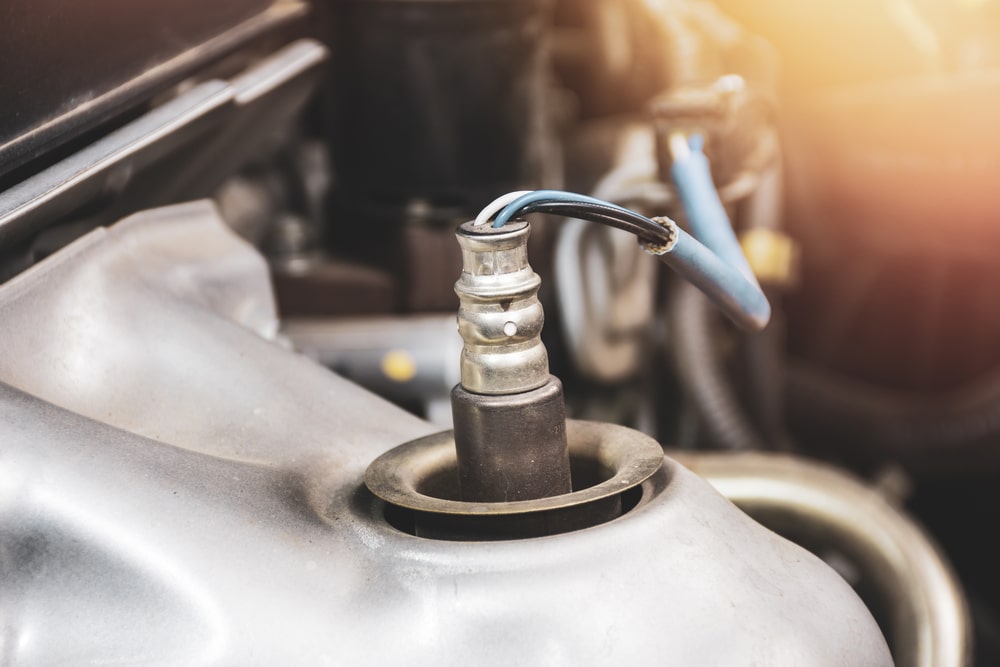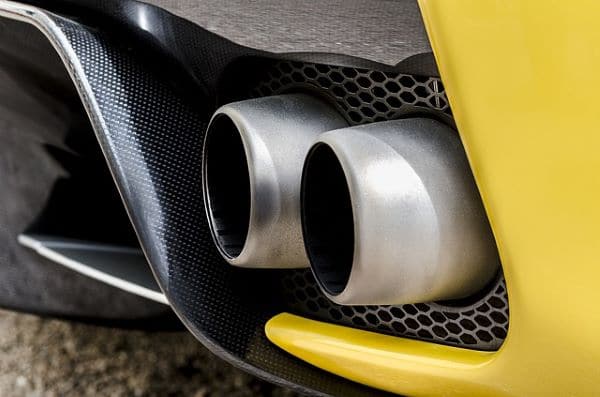How do you know if you have a bad O2 sensor? This vital sensor is found in the engine and often referred to as the oxygen sensor. By the end of this article, you will understand the function of this valuable part and know the answer to – what are the symptoms of a bad oxygen sensor?

Table of Contents
What is the O2 Sensor?
The vehicle’s internal combustion engine produces exhaust gas once the air/fuel mixture was ignited in the cylinders. In these exhaust gases, there are various elements included, such as oxygen and carbon.
The oxygen sensors are responsible for monitoring how much oxygen is in the exhaust gas before it leaves the engine. This is the oxygen that wasn’t burnt during combustion.
Once the sensor determines how much oxygen is leftover, the data is sent back to the engine control module. This central processing unit manages all of the systems of the car and alerts other sensors with directions on what to do.
The ECM knows from this information whether the engine is burning too little or too much fuel. When there is more air than fuel, it causes lean combustion to occur. However, the opposite creates rich combustion. Either of these situations can lead to performance issues.
Bad O2 Sensor Symptoms
Depending on what is wrong with this part, you might notice one of these O2 sensor symptoms. However, not everyone sees the same oxygen sensor symptoms, which is why it’s helpful to have the vehicle scanned for an O2 sensor code to determine what’s wrong.

1. Check Engine Light
The first sign that something is wrong with the O2 sensor is an illuminated Check Engine Light. Anytime the sensor detects too much or too little oxygen, the ECM attempts to control the balance.
However, if the oxygen sensors are sending faulty data, the ECM won’t know that and changes the balance, which in turn hurts the engine performance.
The module then realizes that something isn’t right and it turns on the Check Engine Light. You might get a DTC of P0172 or P0141 when there is a problem with the oxygen sensor.
2. Poor Fuel Economy
A bad O2 sensor causes the air/fuel mixture to be thrown out of whack. When this happens, the system doesn’t receive the right amount of fuel or air, which is going to affect the fuel economy.
If the system is causing more fuel to be burned than needed, you are going to notice it at the fuel pump.
3. Rough Idling
When the engine idles rough, it means that the engine isn’t getting what it needs. You might notice it when you park the vehicle or when you are at a stop sign.
A normal RPM rate during idle is under 1,000. However, the engine RPM might shoot up to 2,000 or 3,000 RPM when the balance is off.
With that said, rough idling isn’t enough to diagnose a faulty O2 sensor. There are many other problems that can also cause this performance issue, such as defective spark plugs or a faulty mass air flow sensor.
4. Poor Engine Performance
When the normal combustion process is altered, you will notice a significant change in the performance. It’s most noticeable when you attempt to step on the gas pedal and nothing happens.
However, this is another bad O2 sensor symptom that could indicate a different problem, which is why code scanner is critical.

5. Failed Emissions Test
If you aren’t in tune with your vehicle, you might not realize you have a bad O2 sensor until you go for your emissions test. Failing an emissions test is not enjoyable, but it’s inevitable if the sensor is bad.
The oxygen sensor is in the exhaust manifold, so it plays a major role in emissions control. Because the faulty sensor is sending the wrong data back to the ECM, you might have the wrong amount of air or fuel in your exhaust gas, which causes your vehicle to fail the test.
Yet, there are other reasons to fail an emissions test, so this symptom doesn’t just belong to the O2 sensor either.
O2 Sensor Location
Oxygen sensors aren’t found at the same place as the map sensor location. They are always in the exhaust system. Both the downstream O2 sensor and upstream O2 sensor monitor how much oxygen remains in the exhaust coming out of the engine.
The downstream O2 sensor symptoms are the same as those that are upstream, the only difference is the location. All O2 sensors are responsible for monitoring the oxygen levels in the exhaust and report the information back to the car’s computer.
To find the O2 sensors, you can reference your vehicle’s service manual. Here are a few tips to help you locate the sensors.
- If your car was built after 1996, there will be a minimum of two O2 sensors.
- Four-cylinder motors have two sensors.
- V6 and V8 motors contain three or four sensors.
- All O2 sensors have one to four wires on them.
- Front sensors are found on the exhaust, under the hood, near the engine.
- Rear sensors are found after the catalytic converter under the vehicle.
Sensors closest to the engine are referred to as pre-cat because they are found before the catalytic converter. These O2 sensors provide oxygen content information before it is treated by the catalytic converter. Any sensor after this vital component is referred to as post-cat, providing data about oxygen levels after treatment.
O2 Sensor Replacement Cost
The bad O2 sensor cost will be between $250 and $400 for most vehicles. For the part alone, you are looking at an oxygen sensor cost of $130 to $250, while the labor might run between $120 and $150.
If you want to keep the oxygen sensors replacement cost to a minimum, you might look at fixing it yourself. However, without a decent amount of mechanical knowledge, this could prove to be difficult, not only to find the sensor but also to replace it. For the cost, it’s sometimes best to have a professional handle the job.
How to Clean Oxygen Sensor?
Once people find the O2 sensors’ prices, they look for ways to lower the cost. Online information provides a ton of articles teaching people how to clean the oxygen sensors, such as this YouTube video.
In these steps, you are told to remove the sensor, apply a cleaner and then put the sensor back. However, these steps aren’t recommended by any car manufacturer.
Oxygen sensors were meant to be replaced when they fail. You might even void the manufacturer warranty if you clean it and cause a defect.
How to Replace a Bad O2 Sensor
If you want to replace the sensor yourself, here are some basic steps to follow.
- Use an OBD II scanner to find the faulty sensor.
- Locate the sensor and disconnect it.
- Remove the sensor with a socket tool.
- Compare the new sensor with the one you removed to ensure they are the same.
- Install the new sensor and connect it.
- Clear the trouble codes with your scan tool.
- Start the engine and go for a test drive to verify the performance issues are resolved.
Here’s a helpful YouTube video if you need more guidance.
Bad O2 Sensor FAQ
Can you drive with a bad O2 sensor?
Yes, you could drive with a faulty O2 sensor, but you don’t want to for long. Otherwise, you are spending more money on fuel and you will eventually destroy your catalytic converter, which is a costly repair.
What causes an oxygen sensor to fail?
O2 sensors fail because of contaminants that have gotten into the exhaust. These contaminants include coolant leaks from faulty head gaskets or a crack in the cylinder wall, as well as phosphorus coming from excessive oil consumption. However, oxygen sensors will also fail from old age.
Do I replace all O2 sensors at once?
You don’t have to replace them all at the same time, but if one is going bad, the others are probably close behind. The only time you wouldn’t want to replace them all is if the oxygen sensor is newer and there was just a defect.
Conclusion
If your car is experiencing performance issues or burning through more fuel, you might have a faulty O2 sensor. Look through the bad O2 sensor symptoms to see if any of them ring true. With your OBD II scan tool, you can figure out what part has gone bad and replace it quickly.
